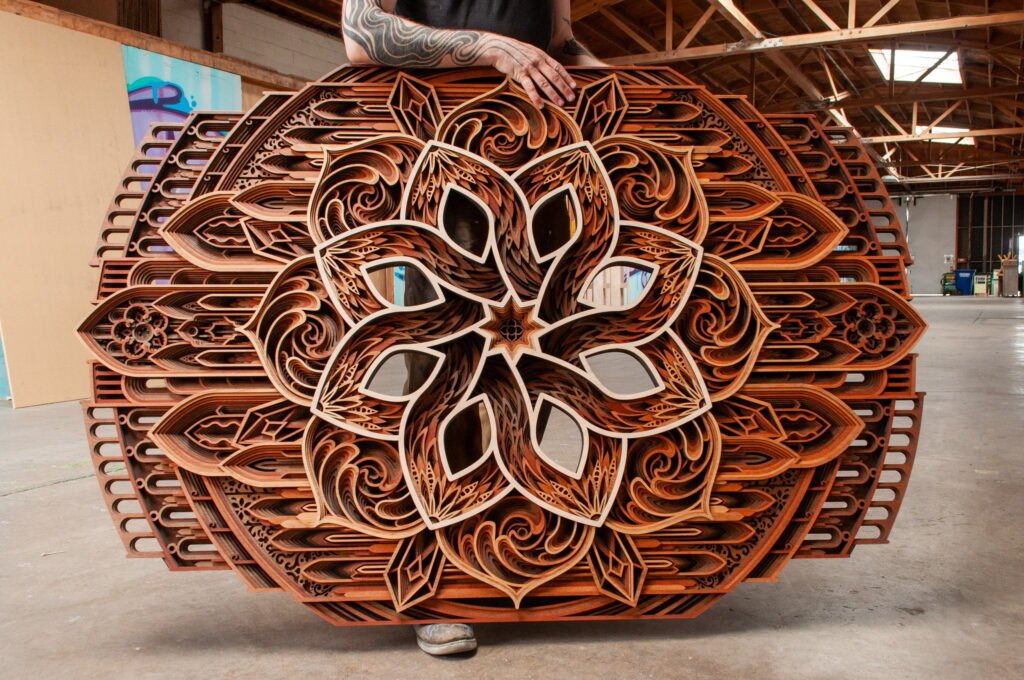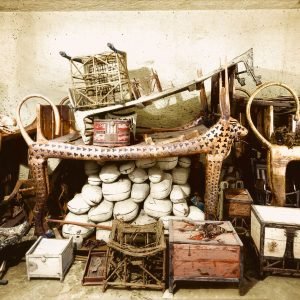In the age of digital craftsmanship, laser machines have revolutionized the way artists and hobbyists approach art and craft creation. These versatile tools offer precision, creativity, and efficiency, enabling the production of intricate designs that were previously challenging to achieve manually. Whether you’re a seasoned artist or a curious beginner, understanding how to create art and crafts with a laser machine can open up a world of possibilities. This comprehensive guide will walk you through the essentials, from selecting the right laser machine to executing your first project.

Understanding Laser Machines
Laser machines, often referred to as laser cutters or engravers, use focused light beams to cut, etch, or engrave materials with high precision. They operate by directing a laser beam through a series of mirrors and lenses to the material’s surface, where it either cuts through or marks the material based on the settings used.
Types of Laser Machines
CO₂ Lasers: Best suited for non-metallic materials like wood, acrylic, fabric, and leather. They are versatile and commonly used for a wide range of crafts.
Fiber Lasers: Primarily used for metal engraving and cutting. They offer high precision and are ideal for metals like stainless steel, aluminum, and brass.
Diode Lasers: Typically used for smaller projects and are less powerful. Suitable for light engraving tasks on materials like paper, cardboard, and thin plastics.
Understanding the type of laser machine you need is crucial, as it directly influences the materials you can work with and the complexity of the designs you can create. Choose an appropriate laser according to the materials you want to use.
Essential Materials for Laser Crafting
The choice of material significantly impacts the outcome of your project. Here are some popular materials used in laser crafting:
Wood
- Plywood: Offers durability and is excellent for intricate designs.
- Bamboo: Eco-friendly and provides a unique aesthetic.
- MDF (Medium-Density Fiberboard): Smooth surface but may produce more smoke during cutting.
Acrylic
- Clear Acrylic: Perfect for projects requiring transparency.
- Colored Acrylic: Adds vibrancy to your designs.
Fabric and Leather
- Cotton and Felt: Ideal for engraving and cutting for apparel and accessories.
- Genuine Leather: Offers a premium look for custom items like wallets and belts.
Paper and Cardboard
- Cardstock: Great for intricate paper crafts and decorations.
- Corrugated Cardboard: Suitable for prototyping and larger projects.
Metals (With Fiber Lasers)
- Stainless Steel: Durable and rust-resistant.
- Aluminum: Lightweight and easily engravable.
Safety Note
Always ensure that the material you choose is laser-safe. Some materials, like PVC, release harmful gases when cut or engraved, which can damage your machine and pose health risks.
Designing Your Artwork
Creating detailed and precise designs is essential for successful laser crafting. Here’s how to get started:
Selecting Design Software
- Adobe Illustrator: A powerful tool for vector-based designs, perfect for detailed projects.
- CorelDRAW: Another excellent vector graphic editor favored by many laser artisans.
- Inkscape: A free, open-source alternative suitable for basic designs.
- LightBurn: Specialized software compatible with various laser machines, offering advanced features for design and machine control.
Design Tips
Use Vector Graphics: Laser machines follow vector paths for cutting and engraving. Ensure your designs are vector-based for crisp and accurate results.
Optimize for Laser Cutting: Avoid overly intricate details that might not translate well when cut. Simplify complex designs to ensure clean cuts.
Set Proper Layers: Assign different colors or layers for cutting and engraving. For example, red lines could indicate cutting paths, while black lines are for engraving.
Test Designs: Before committing to a final project, perform test runs on scrap materials to fine-tune your design and settings.
Importing Designs
Once your design is ready, import it into your laser machine’s software. Ensure that the scale and dimensions match your desired output. Adjust the settings based on the material and the level of detail required.
Setting Up Your Laser Machine
Proper setup is crucial for achieving high-quality results and ensuring safety.
Initial Setup Steps
Assemble the Machine: Follow the manufacturer’s instructions meticulously to assemble your laser machine. Ensure all components are securely in place.
Install Software: Install the necessary software and drivers on your computer. Familiarize yourself with the interface and functionalities.
Calibration: Calibrate the laser machine to ensure accurate cutting and engraving. This involves setting the correct focus distance and aligning the laser head.
Material Placement: Place your chosen material on the laser bed, ensuring it is flat and secure to prevent movement during the process.
Ventilation: Set up proper ventilation to remove smoke and fumes generated during laser operations. This might include exhaust fans or external air filtration systems.
Safety Precautions
Protective Eyewear: Always wear laser safety goggles appropriate for your machine’s wavelength to protect your eyes from potential harm.
Fire Safety: Keep a fire extinguisher nearby, especially when working with flammable materials like wood and paper.
No Flammable Materials: Avoid using materials that catch fire easily or release toxic fumes, such as PVC or certain foams.
Executing Your First Project
Starting with a simple project can help you get accustomed to your laser machine’s operations. When you start the laser engraving process, monitor the machine to ensure everything is functioning correctly and there are no signs of burning or excessive smoke.
Safety Tips and Best Practices
Working with laser machines involves inherent risks. Adhering to safety guidelines ensures a secure and productive crafting environment.
General Safety Tips
Never Leave the Machine Unattended: Always monitor the laser machine while it’s operating to respond promptly to any issues.
Maintain Cleanliness: Keep the laser bed and surrounding area free from debris and flammable materials.
Regular Maintenance: Clean the machine’s mirrors and lenses regularly to ensure optimal performance and reduce fire hazards.
Proper Ventilation: Ensure that ventilation systems are functioning correctly to remove harmful fumes and smoke.
Best Practices
Use Appropriate Settings: Always adjust the laser’s power, speed, and frequency based on the material and desired outcome to prevent damage or poor-quality results.
Opt for High-Quality Materials: Using materials specifically designed for laser cutting and engraving minimizes risks and enhances project quality.
Label and Organize: Keep your materials and tools organized and labeled to streamline your workflow and prevent mistakes.
Stay Informed: Continuously educate yourself about new techniques, materials, and safety protocols to improve your crafting skills and safety awareness.
Advanced Techniques and Tips
Once you’re comfortable with basic laser crafting, you can explore more advanced techniques to elevate your projects.
Layered Engravings
Create depth and dimension in your designs by using multiple engraving passes or varying power settings. This technique is ideal for creating shaded images or complex patterns.
Inlay Projects
Combine laser engraving with inlay techniques to embed materials like metals, acrylics, or colored woods into your designs. This adds a striking contrast and enhances visual appeal.
3D Engravings
Simulate three-dimensional effects by meticulously layering engravings and manipulating depth. While true 3D engraving requires specialized machines, skilled artisans can achieve impressive results with standard laser cutters.
Custom Templates and Jigs
Create reusable templates and jigs to streamline the production of repetitive elements in your projects. This enhances consistency and efficiency, especially for larger batches.
Combining with Other Tools
Integrate laser crafting with other tools and techniques, such as CNC machining, 3D printing, or hand finishing, to produce hybrid projects that showcase a blend of technologies.
Maintenance and Troubleshooting
Proper maintenance extends the lifespan of your laser machine and ensures consistent performance.
Regular Maintenance Tasks
Cleaning: Wipe down the machine’s exterior, laser bed, and exhaust system regularly to remove dust and debris.
Lens Care: Clean the laser lens with appropriate solvents and lint-free cloths to maintain beam quality.
Mirror Alignment: Periodically check and adjust the mirrors to ensure the laser beam remains accurately aligned.
Lubrication: Apply lubrication to moving parts as recommended by the manufacturer to prevent wear and tear.
Common Issues and Solutions
Burn Marks on Materials: Adjust the laser’s power and speed settings. Slower speeds with lower power may reduce burn marks.
Poor Engraving Quality: Ensure the material is properly secured. Check lens cleanliness and mirror alignment.
Machine Not Powering On: Verify all electrical connections are secure. Refer to the user manual for specific troubleshooting steps.
Software Glitches: Keep your laser machine’s software updated. Reinstall software if persistent issues arise.
Conclusion
Creating art and crafts with a laser machine opens up a realm of creative possibilities, blending technology with artistic expression. From simple engraved coasters to intricate inlays and layered artworks, laser machines empower creators to bring their visions to life with precision and efficiency. By understanding the fundamentals—choosing the right machine, selecting suitable materials, mastering design software, and adhering to safety protocols—you can embark on a rewarding journey in laser crafting.







